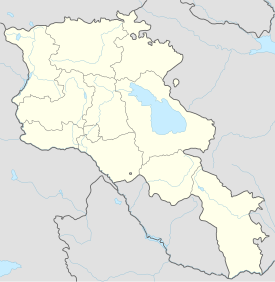Armavir (ancient city)
 The site of ancient Armavir | |
| Location | 1 km west of the current village of Armavir, Armavir Province, Armenia |
|---|---|
| Coordinates | 40°04′55″N 44°02′00″E / 40.08194°N 44.03333°E |
| History | |
| Builder | King Orontes III |
| Founded | 8th century BC rebuilt 331 BC |
| Abandoned | 1603 |
Armavir (
History
Antiquity
The area of ancient Armavir has been inhabited since the 6th millennium BC. Various obsidian instruments, bronze objects and pottery have been found from that period. Armenian accounts held the city to have founded by King Aramais, a grandson of Hayk, around 1980 BC.[1]
During the first half of the 8th century BC, King

According to the 5th-century Armenian historian
In 591 during the reign of
During Antiquity, Armavir was taken by the
Medieval Armavir
Arab rule lasted until the first quarter of the ninth century. The
Ottoman-Persian rule
Kara Koyunlu's sovereignty lasted until
The settlement remained abandoned until 1613, when 7 Armenian families rebuilt a new village just 1 km east of the ancient site of Armavir.
It was occupied by Ottomans between 1635–1636 and 1724–1736. At the fall of the
Russian rule
The
This region formally passed from
References
- ^ Chisholm, Hugh, ed. (1911). . Encyclopædia Britannica. Vol. 2 (11th ed.). Cambridge University Press. p. 563.
- ^ Hakobyan, Tadevos (2007). Hayastani patmakan ashkharhagrutʻyun Հայաստանի պատմական աշխարհագրություն [Historical geography of Armenia] (in Armenian). Yerevan: Yerevan State University Press. p. 133.
- ^ Inscriptions on a rock face at Armavir - in English translation at attalus.org.
- ^ (in French) Tirac'yan, Georg. "Armawir." Translated from Armenian by Aida Tcharkhtchian and edited by Jean-Pierre Mahé. Revue des Études Arméniennes. vol. 27, 1998-2000, p. 137.
- ISBN 5-540-01192-9.
- ^ Movses Khorenatsi. History of Armenia, 2.16, p. 136. Note that modern historians are not convinced that Tigranes II was still alive when Cleopatra became queen of Egypt.
- ^ Movses Khorenatsi. History of Armenia, 2.49, p. 164.
- Jewish Encyclopedia, vol. 1, pp. 116-17.

